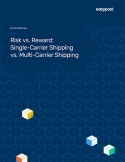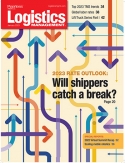Breaking the oligarchy lock on parcel express
Over the years, we watched with growing concern as the consolidation of the domestic small package/express market turned in to what looked and acted like a two-company oligarchy. It was clear that two companies dominated the current and future parcel express market for U.S. shippers.

Logistics in the News
U.S. rail carload and intermodal volumes are mixed, for week ending January 14, reports AAR Single-Carrier vs. Multi-Carrier Shipping Stategies 论坛流动性heralds $400M joint venture with CBRE IM and Series A funding round Catching up with MHI’s Daniel McKinnon 功能处理量货运条件印第安纳州ex improves but remains firmly in negative territory More Logistics NewsLogistics Resource
Single-Carrier vs. Multi-Carrier Shipping Stategies Download the white paper to learn about the benefits of multi-carrier shipping with EasyPost.
Download the white paper to learn about the benefits of multi-carrier shipping with EasyPost.All Resources
Over the years, we watched with growing concern as the consolidation of the domestic small package/express market turned in to what looked and acted like a two-company oligarchy. It was clear that two companies dominated the current and future parcel express market for U.S. shippers.
As a transportation buyer, you could pick UPS or FedEx—or explain to your boss why you were taking chances with a “no-name” local provider. In the meantime, these two public companies announced inflation-plus increases in tandem and did not lower fuel surcharges when fuel prices fell. The two big guys even muted the anticipated entry of theUnited States Postal Service (USPS)into the market, as they co-opted the postal service into being the last-mile solution instead of a full-blown competitor.
USPS can’t raise rates without permission from regulators, so they agreed to take a portion of the private company revenues—and parcel shippers appeared to be stuck.
However, the interesting thing about high margin transaction businesses in the 21st century is that they attract the eye of third parties. We’re seeing the development of technology to manage passengers by ride-sharing firms like Uber and Lyft now being applied to package and express transactions.
And as we’ve been reporting in the pages of Logistics Management, manyless-than-truckload (LTL)carriers are dipping their toes in the water, and big-time parcel shipper Amazon has even entered the market.
So, how can a shipper become a common carrier? Large shippers have been doing it for years, especially when they have enough volume and density to keep a truck busy. But today’s new applications enable one-off transactions, so drivers can pick up loads from multiple sources and keep themselves busy all day.
In this case, the shipper isn’t committing to high fixed costs. This worked in truckload with “load boards” and broker 800 numbers, but the leap to LTL/parcel express seemed impossible until the new applications and smart phones turned that around. Now, add the volume and density of an Amazon or Alibaba.com and you have a new market with savvy operators.
Of course, the most difficult challenge is the last mile, but the good news is that USPS’s last-mile services are public, so any new entrants have a way to fill in the gaps in service areas.
With the two dominant players pushing prices higher at hyper-inflation percentages, there’s certainly room for experimentation by companies like Walmart to have employees make deliveries after work or provide incentives for customers to buy online and pick-up at the store.
I tried this recently at Lowes. Rather than go wandering up and down aisles at the big box store trying to find a particular door lock set, I found it online at my desk and simply went to the pick-up counter at the front of the store for simple collection. It was boxed and waiting for my arrival. Alternatively, they would have also delivered my purchase.
This omni-channel shopping is an enabler of “Uberized” delivery, and thus the small package/express market is booming. I include self-pickup in the mix as it saves time and money for the customer. In the meantime, higher volumes and good margins mean more technology-enabled competition will enter the market so creativity can thrive.
And keep in mind that applying this approach to B2B shipments also works when shippers cooperate in combining loads directly or through third-party providers. The good news for shippers is that we have some options today—with more to come tomorrow.

About the Author
 Peter MoorePeter Moore is Adjunct Professor of Supply Chain at Georgia College EMBA Program, Program Faculty at the Center for Executive Education at the University of Tennessee, and Adjunct Professor at the University of South Carolina Beaufort. Peter writes from his home in Hilton Head Island, S.C., and can be reached at[email protected]
Peter MoorePeter Moore is Adjunct Professor of Supply Chain at Georgia College EMBA Program, Program Faculty at the Center for Executive Education at the University of Tennessee, and Adjunct Professor at the University of South Carolina Beaufort. Peter writes from his home in Hilton Head Island, S.C., and can be reached at[email protected]

Subscribe to Logistics Management Magazine!
Subscribe today. It's FREE!Get timely insider information that you can use to better manage your entire logistics operation.
Start your FREE subscription today!
 Single-Carrier vs. Multi-Carrier Shipping Stategies
Download the white paper to learn about the benefits of multi-carrier shipping with EasyPost.
Download Today!
Single-Carrier vs. Multi-Carrier Shipping Stategies
Download the white paper to learn about the benefits of multi-carrier shipping with EasyPost.
Download Today!
 Our annual gathering of freight transportation industry analysts reveals some common themes, largely around the notion that rates are not likely to increase much—if at all—in some modes and will continue declining in others. Does this mean things are stabilizing?
Our annual gathering of freight transportation industry analysts reveals some common themes, largely around the notion that rates are not likely to increase much—if at all—in some modes and will continue declining in others. Does this mean things are stabilizing?LM Viewpoint on the 2023 Rate Outlook: Will shippers catch a break? Global Labor Rates: China is no longer a low-cost country View More From this Issue
 2023 Rate Outlook Webcast: Will shippers catch a break?
In this annual webcast, group editorial director Michael Levans hosts our panel of logistics and freight transportation analysts who share their insights on rate patterns in all the major transport modes in an effort to help shippers prepare their freight transportation budget for the coming year.
Register Today!
2023 Rate Outlook Webcast: Will shippers catch a break?
In this annual webcast, group editorial director Michael Levans hosts our panel of logistics and freight transportation analysts who share their insights on rate patterns in all the major transport modes in an effort to help shippers prepare their freight transportation budget for the coming year.
Register Today!








